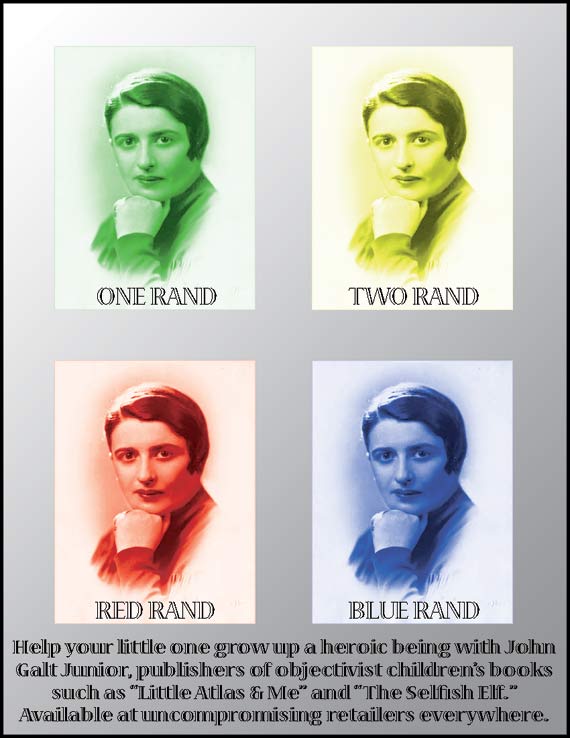Elizabethia-based publisher John Galt Junior Books has been in the children’s book business for over 30 years, releasing stories rooted firmly in the philosophy of Ayn Rand. JGJ Books lives by the credo that even the least-productive, least-deserving members of society should be given a chance to fall in love with selfishness. While their entertainment and educational value for children is dubious, an adult could spend hours of fun with these books.
Take one of the imprint’s first releases “Little Atlas & Me.” The book features the publisher’s eponymous hero, John Galt Junior, as the “Little Atlas” of the metaphor, and his hapless companion Joey Looter. John first introduces Joey to the principles of objectivism when he takes Joe’s crayons. While Joey merely eats the implements, John is the class’ best artist (he explains) and so deserves to have the crayons more than the talentless Joey. John also takes a swipe at collectivism by castigating his teacher for providing the crayons for the class rather than forcing them to come up with creative tools on their own recognizance. Just not in so many words.
The most disturbing part is, of course, when the entire class gets together towards the end to help out a classmate’s family in need. The three page Galt soliloquy which follows centres around self-reliance, creativity, and the squelching of compassion. Before long, John takes class-clown Benny Rearden with him on strike under the jungle gym.
A short list of some of JGJ Books’ titles offers further insight:
“Sharing is Evil”
“Do Unto Others (As Much as You Can)”
“Goodnight Communism”
“The Bridge to Personal Freedom of Choice”
“A Parent’s Guide to Teaching Kids About Sex the Rand Way”
In “The Selfish Elf” one of Santa’s elves must save society by forcing the world’s children to work for their Christmas Gifts, in a strange twist on the traditional saving Christmas tale. The Selfish Elf creates his own factory in which to create talent-appropriate toys, thus putting Santa Claus’ factory out of business, saving civilization, and saving Christmas for the productive denizens of the world.

The firm takes us on another wild romp with “The Water Fountain.” Young Howie Roark wants a drinking fountain at the local Mall, but the owners of the property (Randians themselves) refuse to put on there for him. Our courageous Howie works all summer cleaning boats at the marina with his new boat-cleaning invention and eventually raises enough money to purchase his own fountain and lease mall space in which to install it. He plans to refuse to let anyone use the water fountain, but when he arrives after its weekend installation to discover that it has been painted a different colour than he specified, he runs it over with a security golf cart instead.
Of course John Galt Junior Books doesn’t leave out your youngest ones who are just learning how to read. For them the venerable publisher provides stunning titles like “One Rand, Two Rand, Red Rand, Blue Rand,” which was somehow able to evade the estate of Theodor Geisel and accusations of hypocrisy and plagiarism to become one of their best-selling titles ever. The book teaches counting using the remarkably frightening visage of Ms. Rand, words such as “productive achievement” and “mind-independent reality,” and teaches all about social value through the ridicule of the machinists, carpenters, and anyone else who works for others (especially with the hands).
Most startling is the young adult book “Randalaughandahalf” which is ostensibly a joke book for teens. Our favourite rip-tickler from this tome is a standard chicken crossing the road joke whose punchline is “ to acquire further materials with which to construct society’s next great invention.” Another is a standard “Yo Momma” joke which we think might just be a compliment in the Randian universe.
“Yo Momma’s so ugly she’s forced to stay at home and make bolt-application in car productions lines more efficient.” The knock-knock jokes aren’t much better and we won’t repeat them here. We’re sure you can just imagine.
It’s not exactly clear how this publishing house has survived for three decades, or who is buying the books it does sell, but one thing’s for sure: these books suck for children. Everything about Randian Objectivism is faulty if not downright incorrect, and to indoctrinate children (or attempt to do so) with colourful pictures and familiar stories is inexcusable, unless of course you happen to be pure, correct and powerful, in which case the regular rules of children’s publishing don’t apply to you.
